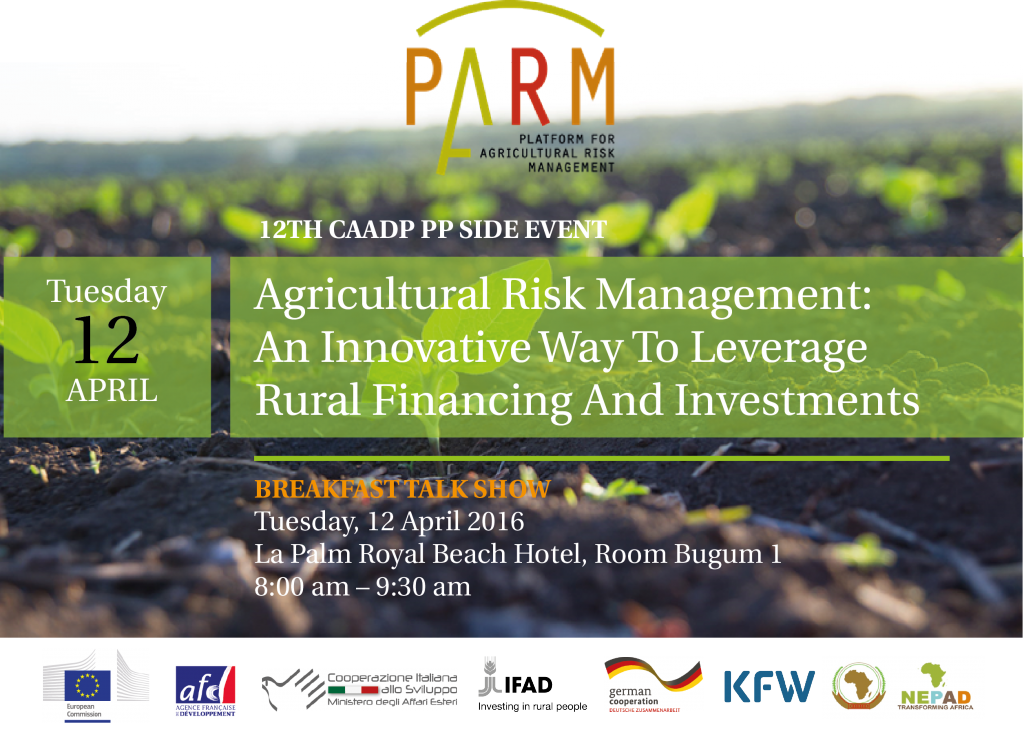
This year, the CAADP PP will take place in Accra (Ghana) from 11 to 15 April 2016 and is organised under the theme “Innovative Financing and Renewed Partnership” to accelerate CAADP Implementation.

The theme aims to focus the PP discussions on two main thrusts, namely: (a) innovative policy and institutional actions and instruments to enable expanded availability and access to appropriate investment financing across the agricultural/agribusiness and agro-industry value chain; and (b) experiences, lessons on modalities, tools and enabling political economy factors to foster partnerships and alliances in pursuit of the Malabo commitments.
Given PARM and NEPAD active role in support of the CAADP process in the selected countries in the field of agricultural risk management, the meeting represents an opportunity to contribute to the discussions and bring lessons to the audience, in particular on the sub-theme 6: Agriculture and Food Insecurity Risk Management.
In this context, PARM will host a side event on:
Agricultural Risk Management: an innovative way to leverage rural financing and investments
Date: Tuesday, 12 April 2016
Time: 8:00 am – 9:30 am (breakfast will be provided)
Location: La Palm Royal Beach Hotel, Room Bugum 1
About the Event
The event would be a BREAKFAST TALK SHOW where participants will meet for breakfast (catered by PARM) and will be set in a TALK SHOW format with a journalist/facilitator which will animate discussions among key speakers from development partners, government and experts to share lessons.
Facilitator:
Ernest Senyo Dzandu
Speakers:
- Jesus Anton, Senior Programme Manager, PARM/IFAD
- Mariam Soumare, Programme Officer and Food Security Analyst, NEPAD
- Laketch Mikael, Director, ATA, Ethiopia
- Lucy Nyarenda, Division Head, Country Engagement Management Division, ARC
- Kadir Osman Gyasi, Senior Agriculture Economist, WORLD BANK
- Nestor Nibitanga, Programme Assistant, AFRACA
- Dr. Sanon Yacouba, focal point PNIA (programmes nationaux d’investissements agricoles ) and PRIA (Programme Régional d’Investissement Agricole), Directorate of Agriculture and Rural Development (DARD), ECOWAS
VIDEO INTRO
A holistic approach to Agricultural Risk Management
A short awareness video will be broadcasted to introduce the audience to ARM holistic approach.
PANEL 1
How agricultural risk management tools can facilitate access to finance and investments contributing to agricultural transformation?
Risk management has at least two positive impacts: it improves food security at farmer, community and global levels, and it enhances public and private investments in agriculture. It is therefore an essential approach for reaching CAADP/NEPAD’s objectives of improving food security and enhancing agricultural productivity in Africa. A properly designed agricultural risk management strategy is crucial to foster the development of rural finance. It requires: good governance, predictability in government decision making (therefore a clear government intervention strategy), public/private partnership, and the provision of public goods.
PANEL 2
How to implement ARM? From risk assessment to investment plans. Experiences
Designing a risk management strategy requires as a prerequisite a comprehensive risk assessment and analysis of interrelated risks. It also requires a holistic and demand driven approach not only focused on agricultural production issues. It should address all sources of risks such as markets, climate, diseases and infrastructure, but also a diversity of very broadly defined ARM tools on-farm, financial and policy related, including information systems, trade policies and regulations, infrastructure, food security and nutrition issues, budget management, and credit systems. This is the basis for a good Agricultural Risk Management System with a good definition of layers of risk and responsibility. Most mitigation tools require the provision of public goods (market and transport infrastructure, agriculture information systems, public guarantees or safety nets) as well as private initiatives (from traders, farmers associations, banks or microfinance institutions, insurance companies, etc.). No single tool can address the full range of risks and no single tool is sufficient to fully hedge any type of risk. What is needed is therefore a combination of tools addressing production, and market risks for each country, depending on its risk profile and allowing farmers and other actors in the food chain to define the portfolio of assets and tools that best fits his risk profile. A risk management strategy requires therefore a tailor made and flexible strategy for each country defining its priorities derived from a rigorous risk analysis and policy engagement process with stakeholders. This is a complex exercise leading to specific ARM investments, and the experience in different countries is a valuable source of knowledge.